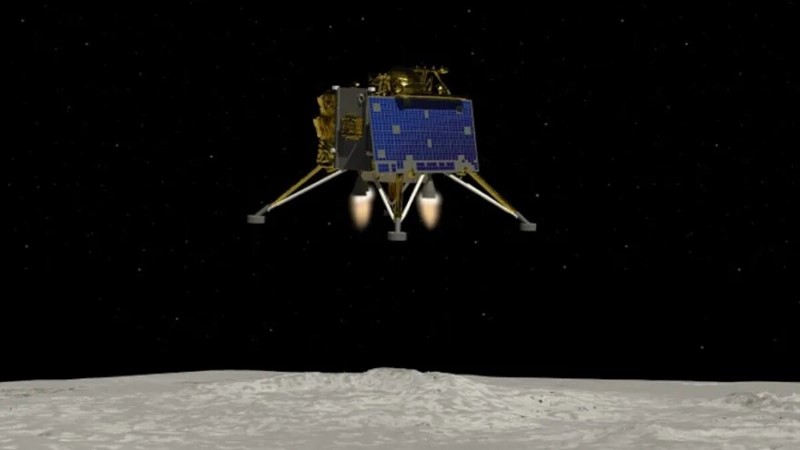In a groundbreaking experiment reminiscent of Vikram Lander’s hop on the Moon, the Propulsion Module (PM) of Chandrayaan-3 has embarked on an extraordinary journey from lunar orbit back to Earth. This unique manoeuvre comes after successfully completing Chandrayaan-3’s primary mission objectives.
சந்திரனில் விக்ரம் லேண்டரின் ஹாப் ஹாப் போன்ற ஒரு அற்புதமான சோதனையில், சந்திரயான்-3 இன் உந்துவிசை பகுதி (Propulsion Module) சந்திரனின் சுற்றுப்பாதையில் இருந்து பூமிக்கு மீண்டும் ஒரு அசாதாரண பயணத்தை தொடங்கியுள்ளது. இந்த தனித்துவமான நிகழ்வு சந்திரயான் -3 இன் முதன்மை பணி நோக்கங்களை வெற்றிகரமாக முடித்த பிறகு வருகிறது.

ஜூலை 14, 2023 அன்று, சந்திரயான்-3 ஆனது LVM3-M4 வாகனத்தில் ஏவப்பட்டது, சந்திரனின் தென் துருவப் பகுதிக்கு அருகில் ஒரு மென்மையான தரையிறக்கத்தை நிரூபித்து, விக்ரம் லேண்டர் மற்றும் பிரக்யான் ரோவரில் உள்ள கருவிகளைப் பயன்படுத்தி சோதனைகளை நடத்துவதை நோக்கமாகக் கொண்டது. ஆகஸ்ட் 23 அன்று சந்திரனில் விக்ரம் வரலாற்றுச் சிறப்புமிக்க தொடுதலைப் பார்த்தது, அதைத் தொடர்ந்து பிரக்யான் ரோவர் அனுப்பப்பட்டது. இரண்டும் ஒரு சந்திர நாளுக்குத் தொடர்ந்து செயல்பட்டனர், பணியின் முதன்மை இலக்குகளை நிறைவேற்றினர்.
உந்துவிசை பகுதியின் (Propulsion Module) முக்கிய பங்கு, லேண்டர் தொகுதியை புவிநிலை பரிமாற்ற சுற்றுப்பாதையில் (GTO) இருந்து இறுதி சந்திர துருவ வட்ட சுற்றுப்பாதைக்கு கொண்டு செல்வது மற்றும் லேண்டரை வெற்றிகரமாக பிரிப்பது. பிரிந்ததைத் தொடர்ந்து, PM இல் உள்ள வாழக்கூடிய SHAPE பேலோடின் ஸ்பெக்ட்ரோ-போலரிமெட்ரி இயக்கப்பட்டது. ஆரம்பத்தில் மூன்று மாதங்களுக்கு திட்டமிடப்பட்டது, உகந்த சுற்றுப்பாதை ஊசி மற்றும் எரியும் சூழ்ச்சிகள் ஒரு மாத சந்திர செயல்பாடுகளுக்குப் பிறகு 100 கிலோவுக்கும் அதிகமான எரிபொருளை பிரதமரிடம் விட்டுச் சென்றன.
இந்த உபரி எரிபொருளை திறம்பட பயன்படுத்தவும் மற்றும் எதிர்கால நிலவு பயணங்களுக்கு கூடுதல் தகவல்களை சேகரிக்கவும், PM ஐ பொருத்தமான புவி சுற்றுப்பாதையில் மீண்டும் சுற்றுவதற்கான முடிவு எடுக்கப்பட்டது. மோதலைத் தவிர்க்கவும், தற்போதுள்ள ஜியோ செயற்கைக்கோள்களின் (GTO சுற்றுவட்ட பாதையில் உள்ள செயற்கைகோள்கள்) பாதுகாப்பை உறுதி செய்யவும் வடிவமைக்கப்பட்ட பணித் திட்டம், அக்டோபர் 2023 இல் செயல்படுத்தப்பட்டது.
Propulsion Module பல இக்கட்டான சூழ்நிலைகளை மேற்கொண்டு, சுற்றுப்பாதை மாற்றுவதை சரி செய்தார். அக்டோபர் 13, 2023 அன்று ஒரு குறிப்பிடத்தக்க டிரான்ஸ்-எர்த் இன்ஜெக்ஷன் (TEI) சூழ்ச்சி, PM பூமிக்கு திரும்புவதற்கான களத்தை அமைத்தது. TEI-க்குப் பின், உந்துவிசை தொகுதி நவம்பர் 10 அன்று சந்திரனின் செல்வாக்கின் கோளத்திலிருந்து புறப்படுவதற்கு முன் நான்கு மூன் ஃப்ளை-பைகளை நிறைவு செய்தது.
சமீபத்திய புதுப்பிப்பின்படி, Propulsion Module பூமியைச் சுற்றி வருகிறது, நவம்பர் 22 அன்று 1.54 லட்சம் கிமீ உயரத்தில் அதன் முதல் பெரிஜியைக் கடந்தது. சுற்றுப்பாதையின் காலம் 27 டிகிரி சாய்வுடன் தோராயமாக 13 நாட்கள் ஆகும், மேலும் பூமியைச் சுற்றி வரும் செயற்கைக்கோள்களுக்கு உடனடி அச்சுறுத்தல்கள் இல்லை என்று கணிப்புகள் குறிப்பிடுகின்றன.
பூமியை கவனிப்பதற்காக வடிவமைக்கப்பட்ட SHAPE பேலோட், பூமி அதன் பார்வையில் இருக்கும்போதெல்லாம் தொடர்ந்து இயங்குகிறது. குறிப்பிடத்தக்க வகையில், அக்டோபர் 28, 2023 அன்று சூரிய கிரகணத்தின் போது ஒரு சிறப்பு நடவடிக்கை, பேலோடின் பல்துறைத் திறனைக் காட்டியது. யுஆர் ராவ் செயற்கைக்கோள் மையம்/இஸ்ரோவின் விமான இயக்கவியல் குழு, இந்த சிக்கலான சூழ்ச்சிகளைத் திட்டமிடுவதற்கும் செயல்படுத்துவதற்கும் முதல் கொள்கைகளிலிருந்து பகுப்பாய்வுக் கருவியை உருவாக்குவதில் முக்கியப் பங்கு வகித்தது.
சந்திரயான்-3 PM இன் திரும்பும் சூழ்ச்சிகளின் முக்கிய முடிவுகள் சந்திரனில் இருந்து பூமிக்கு செல்லும் பாதைகள் மற்றும் சூழ்ச்சிகளை வெற்றிகரமாக திட்டமிடுதல் மற்றும் செயல்படுத்துதல், சூழ்ச்சி திட்டமிடலுக்கான மென்பொருள் தொகுதி உருவாக்கம் மற்றும் வான உடல்கள் முழுவதும் ஈர்ப்பு உதவியுடன் பறக்கும் பயணத்தை செயல்படுத்துதல் ஆகியவை அடங்கும். முக்கியமாக, நிலவின் மேற்பரப்பில் கட்டுப்பாடற்ற விபத்துகளைத் தவிர்க்கும் திறனையும், குப்பைகள் உருவாக்குவதைக் குறைக்கும் அர்ப்பணிப்புடன் இணைந்திருப்பதையும் இந்த பணி நிரூபித்துள்ளது.
இந்த குறிப்பிடத்தக்க பயணம் இந்தியாவின் விண்வெளி ஆய்வு சாதனைகளை சேர்ப்பது மட்டுமல்லாமல் எதிர்கால சந்திர பயணங்களுக்கும் வழி வகுக்கிறது, விண்வெளி ஆய்வில் சிக்கலான சூழ்ச்சிகளை திட்டமிட்டு செயல்படுத்துவதில் இஸ்ரோவின் திறமையை வெளிப்படுத்துகிறது. சந்திரயான்-3ல் இருந்து கற்றுக்கொண்ட பாடங்கள், விண்வெளி ஆய்வில் புதிய எல்லைகளைத் திறந்து, வரவிருக்கும் பயணங்களின் வெற்றிக்கு சந்தேகத்திற்கு இடமின்றி உதவும்.
In a groundbreaking experiment reminiscent of Vikram Lander’s hop on the Moon, the Propulsion Module (PM) of Chandrayaan-3 has embarked on an extraordinary journey from lunar orbit back to Earth. This unique manoeuvre comes after successfully completing Chandrayaan-3’s primary mission objectives.

Chandrayaan 3’s Soft Landing – Artist Impression
Launched on July 14, 2023, aboard the LVM3-M4 vehicle from SDSC, SHAR, Chandrayaan-3 aimed to demonstrate a soft landing near the lunar south polar region and conduct experiments using the instruments on the Vikram Lander and Pragyaan Rover. The mission witnessed the historic touchdown of Vikram on the Moon on August 23, followed by the deployment of the Pragyaan rover. Both operated continuously for one lunar day, fulfilling the mission’s primary goals.
The Propulsion Module’s main role was to transport the Lander module from the Geostationary Transfer Orbit (GTO) to the final lunar polar circular orbit, successfully separating the Lander. Subsequent to separation, the Spectro-polarimetry of the Habitable Planet Earth (SHAPE) payload in the PM was operated. Initially planned for three months, the optimal orbit injection and burn manoeuvres left the PM with over 100 kg of fuel after a month of lunar operations.
To utilize this surplus fuel effectively and gather additional information for future lunar missions, a decision was made to re-orbit the PM to a suitable Earth orbit. The mission plan, designed to avoid collisions and ensure the safety to existing GEO satellites, was executed in October 2023.
The PM underwent multiple manoeuvres, raising apolune altitude and adjusting the orbit period. A significant Trans-Earth Injection (TEI) manoeuvre on October 13, 2023, set the stage for the PM’s return to Earth. Post-TEI, the propulsion module completed four Moon fly-bys before departing the Moon’s Sphere of Influence on November 10.
As of the latest update, the PM is orbiting Earth, having crossed its first perigee on November 22 with an altitude of 1.54 lakhs km. The orbit’s period is approximately 13 days with a 27-degree inclination, and predictions indicate no imminent threats to operational Earth-orbiting satellites.
The SHAPE payload, designed for Earth observation, continues to operate whenever Earth is in its field of view. Notably, a special operation during a Solar Eclipse on October 28, 2023, showcased the versatility of the payload. The UR Rao Satellite Centre/ISRO’s flight dynamics team played a crucial role, in developing an analysis tool from first principles to plan and execute these complex maneuvers.
Key outcomes from Chandrayaan-3 PM’s return manoeuvres include the successful planning and execution of trajectories and manoeuvres from the Moon to Earth, the development of a software module for manoeuvre planning, and the execution of a gravity-assisted flyby across celestial bodies. Importantly, the mission has also demonstrated the ability to avoid uncontrolled crashes on the Moon’s surface, aligning with the commitment to minimize debris creation.
This remarkable journey not only adds to India’s space exploration achievements but also paves the way for future lunar missions, showcasing the prowess of ISRO in planning and executing complex manoeuvres in space exploration. The lessons learned from Chandrayaan-3 will undoubtedly contribute to the success of upcoming missions, opening new frontiers in space exploration.

